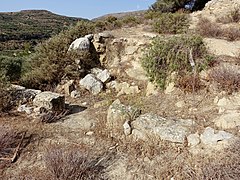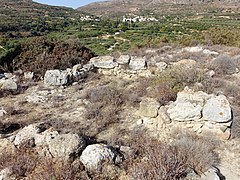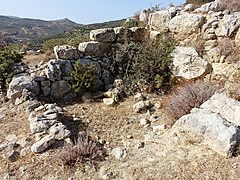Minoan villa of Agios Georgios
The Minoan villa of Agios Georgios ( Greek Μινωική έπαυλη Αγίου Γεωργίου Minoiki epavli Agiou Georgiou ) is an archaeological excavation site in the east of the Greek island of Crete . It is located in the municipality of Sitia in the Lasithi regional district , about 600 meters east of the village of Agios Georgios ( Άγιος Γεώργιος ) near the road from Epano Episkopi to Agios Spyridon and Nea Presos. The generic term "Minoan villa" describes a type of building that is largely limited to the new palace period of the Minoan culture .
Location and history
The "Minoan Villa" of Agios Georgios is almost 300 meters above sea level on the Profitis Ilias hill ( Προφήτης Ηλίας ), after which the archaeological site is officially named. In 1959, the amateur archaeologist Manolis Fygetakis from Vaveli (Nea Presos) referred to the site, whereupon it was excavated in 1959 and 1960 under the direction of Nikolaos Plato . At that time the place Agios Georgios was still called Tourtouli ( Τουρτούλοι ). The distance from the "Minoan Villa" from Agios Georgios to the north coast of Crete on the bay of Sitia of the Cretan Sea is approximately 9.3 kilometers as the crow flies , and 12.8 kilometers to the south coast on the Levantine Sea at Makrygialos . The first acropolis of the archaeological site of Praisos , the city of the Eteocretes , is 1.5 kilometers to the east.
The building of the "Minoan Villa" of Agios Georgios consisted of more than 30 rooms on five levels. It took up an area of 700 m², part of the complex being destroyed by landslides. The remaining parts of the building are poorly preserved, especially in the lower area. Parts of the complex were destroyed by early Christian burials in Byzantine times. A found three-leafed half-column capital, similar to a stone capital from the palace of Knossos, indicates the exclusivity of the building . The entrance area to the “villa” is assumed to be in the southeast (room Α). The most important, high-quality parts of the building were on the upper two levels, each of which was accessed by a corridor on the east side. Both levels are connected by a staircase from the south, nine of which have been preserved in situ .
The "Minoan Villa" on the Prophet Elias is one of the archaeological sites with closed Fund contexts pure SM IA - ceramic . Since this late Minoan ceramic style was in use in East Crete until SM I B, a later destruction of the building than in SM I A cannot be ruled out. The jars were found in the top level storerooms. The upper rooms also contained millstones, a potter's wheel and accessories for a wine press. Another wine press was found on the lowest level. There may also be a kitchen there. In five rooms on the second highest level there was a multitude of weaving weights , an indication of the manufacture of textiles. Valuable objects were not discovered during the excavations, also no objects with religious or ceremonial significance. It is likely that the "villa" was surrounded by a small settlement.
- Excavation site
Individual evidence
- ↑ Sabine Westerburg-Eberl: "Minoan Villas" in the New Palace period on Crete . In: Harald Siebenmorgen (Ed.): In the Labyrinth of Minos: Crete - the first European high culture [Exhibition of the Badisches Landesmuseum, 27.1. until April 29, 2001, Karlsruhe, Schloss] . Biering & Brinkmann, Munich 2000, ISBN 3-930609-26-6 , pp. 87 ( PDF; 1.6 MB ).
- ^ Profitis Iliad. Archaeological Atlas of Crete: Archaeological Sites. Forth: Institute for Mediterranean Studies, accessed January 29, 2017 .
- ↑ a b Η Μινωική έπαυλη του Αϊ Λιά στο χωριό Τουρτούλοι . The Minoan villa of St. Elias in the village Tourtouli (today's Agios Georgios). ionkeftiu-cretanbull, October 14, 2012, accessed January 29, 2017 (Greek / English).
- ^ Donald C. Haggis, Carla M. Antonaccio: Classical Archeology in Context: Theory and Practice in Excavation in the Greek World . De Gruyter, Berlin / Boston 2015, ISBN 978-1-934078-46-4 , The Greek Tradition, p. 36 (English, digitized version [accessed on January 29, 2017]).
- ↑ a b c d Agios Georgios. Minoan Crete, July 12, 2015, accessed January 29, 2017 .
- ↑ Sabine Westerburg-Eberl: "Minoan Villas" in the New Palace period on Crete . In: Harald Siebenmorgen (Ed.): In the Labyrinth of Minos: Crete - the first European high culture [Exhibition of the Badisches Landesmuseum, 27.1. until April 29, 2001, Karlsruhe, Schloss] . Biering & Brinkmann, Munich 2000, ISBN 3-930609-26-6 , pp. 92 ( PDF; 1.6 MB ).
- ↑ Wolf-Dietrich Niemeier : The catastrophe of Thera and the late Minoan chronology . In: Yearbook of the German Archaeological Institute . tape 95 . De Gruyter, Berlin 1980, ISBN 3-11-008183-0 , p. 18 ( digitized version [accessed on January 29, 2017]).
- ^ Maria Emanuela Alberti: Textile Industry Indicators in Minoan Work Areas: Problems of Typology and Interpretation . In: Carmen Alfaro Giner, L. Karalē (ed.): Purpureae Vestes II: Vestidos, textiles y tintes . Universitat de València, Valencia 2008, ISBN 978-84-370-8683-5 , p. 26 (English, digitized version [accessed on January 29, 2017]).
Web links
- Profitis Iliad. In: Digital Crete: Archaeological Atlas of Crete. Foundation for Research and Technology-Hellas (FORTH), Institute for Mediterranean Studies(English).
- Agios Georgios. Minoan Crete, July 12, 2015, accessed January 29, 2017 .
- Agios Georgios Crete. www.crete.org.uk, August 24, 2015, accessed January 29, 2017 .
Coordinates: 35 ° 7 ′ 30 ″ N , 26 ° 4 ′ 26.9 ″ E






